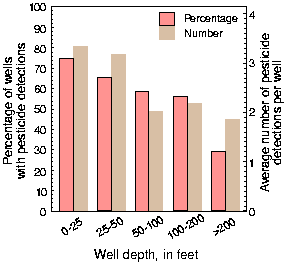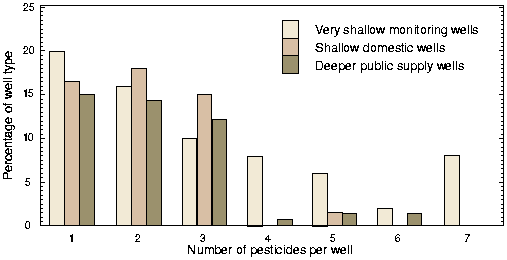Figure 18. Locations of wells sampled for pesticides and volatile organic compounds in the Central Columbia Plateau.
Samples from 255 wells in the Central Columbia Plateau were analyzed for 145 pesticides and volatile organic compounds (figs. 18, 20). Volatile organic compounds (VOCs) are used as solvents or metal degreasers and as pesticides (as inert ingredients or active ingredients to kill nematodes, insects, bacteria, or rodents). There were 24 pesticides and 15 VOCs detected; concentrations were mostly well below drinking water standards, ranging from the method detection limit (as low as 0.001 microgram per liter) to a maximum of 7.3 micrograms per liter for 1,2-dichloropropane (see p. 26). The significance of such low concentrations in drinking water is not clear; and in addition, no drinking water standards or guidelines have been established for 40 percent of the pesticides or VOCs analyzed. In the Quincy-Pasco subunit, four of the commonly used pesticides (herbicides or insecticides) were detected in ground water [19, 20]. In the Palouse subunit, none of the commonly used pesticides were detected in ground water [21].
Only concentrations of 1,2-dichloropropane in one well and 1,2-dibromoethane (EDB) in two wells exceed the MCL. Both of these compounds are VOCs used as soil fumigants that were phased out in the late 1970s and 1980s, respectively. Herbicides, though applied in greater amounts and detected more frequently than other types of pesticides, were not detected at concentrations that exceed MCLs. Most of the newer pesticides break down more rapidly and thus are less persistent in the environment than the discontinued ones; they were not detected at concentrations above drinking water standards or guidelines [19, 20, 45].
Shallower wells have a greater number and percentage of pesticide detections [44]. Most people in the Central Columbia Plateau drink water from public supply wells (fig. 5), which are generally deeper than domestic wells (and deeper than this study's monitoring wells), and therefore contain water that is less susceptible to contamination. However, similar pesticides at similar concentrations have been detected in public supply wells, shallow domestic wells, and very shallow monitoring wells (fig. 20), indicating that some contamination does reach deeper wells. This could be due to faulty well construction, high pumpage rates, or local ground-water pathways (relatively common in fractured basalt aquifers) that allow water to move quickly to greater depths.
Samples from five public supply wells contained only p,p'-DDE, a breakdown product of DDT, which was discontinued for sale in the United States in the early 1970s. More modern pesticides were not detected, suggesting that these deeper wells are probably withdrawing older ground water that predates the use of newer pesticides.
Low concentrations of pesticides and VOCs were detected in 60 percent of samples from 117 shallow domestic and monitoring wells and in 46 percent of samples from 138 deeper public supply wells. Modern pesticides may get to shallow ground water before they have had time to break down; therefore, shallow wells tend to have a higher rate of detections. Thirty-one pesticides and VOCs were detected in samples from shallow domestic and monitoring wells, whereas 18 pesticides and VOCs were detected in samples from public supply wells.

Figure 19. Shallow wells have a greater number and percentage of pesticide detections.
Figure 20. Idealized cross section of ground-water system in the Quincy-Pasco subunit. Three types of wells were sampled for pesticides and VOCs: very shallow monitoring wells installed for sampling purposes near the water table, shallow domestic wells, and deeper public supply wells. Median depths of the wells were 36 feet, 119 feet, and 197 feet, respectively.
Of samples with detections, 66 percent contained more than one pesticide. Generally, the highest frequency of multiple detections occurred in samples from very shallow monitoring wells (fig. 21). Current drinking water standards or guidelines are only for individual compounds; no standards or guidelines have been established for multiple pesticides in drinking water. Health effects of combinations of pesticides in drinking water are not clearly understood.

Figure 21. Most detections of more than one pesticide occurred in samples from very shallow monitoring wells.
|
Many chemicals, including nitrate and pesticides, can leach through the soil to ground water. Pesticides are present in more than one-half of wells in the plateau that contain elevated nitrate concentrations (above the "natural" or background level of 2-3 mg/L [12]). Indeed, the higher the nitrate concentration, the greater the percentage of wells with pesticides (fig. 22). Because of this consistent correlation, sampling for nitrate may be cost effective for identifying wells that may be at risk of pesticide contamination. Nitrate testing is far less expensive than pesticide testing, and the latter could then be targeted more carefully. |
Figure 22. Pesticide detections correlate with nitrate concentrations. |
Radon, a naturally occurring, radioactive decay product of radium, is a water-soluble gas from bedrock that emits high-energy alpha particles that can damage lung tissue. The primary health risk from radon and its decay products appears to be from inhalation of the gas, although there is an increased health risk from drinking water with high concentrations of radon. Dissolved radon is easily released into the air when water is used for showering and other purposes. In 151 ground-water samples, radon concentrations ranged from 110 to 4,100 picocuries per liter (pCi/L); the median concentration was 530 pCi/L, similar to the median in many parts of the United States (p. 23).